In our previous article, we offered an historical summary of how central banking – sometimes reviled and almost always under suspicion – emerged at the birth of the United States (through the leadership of Alexander Hamilton) and then experienced notable ebbs and flows through the following 235 years of U.S. history. Within that long history, a couple of consistent patterns became clear:
1) War virtually always made the existence and effective operation of a central bank essential – to play its central role in the management of escalating federal government spending prompted by the high costs of warfare.
2) Left unregulated, banks (and bankers) tend to disrupt the national economy in one way or another – as evidenced through the regularity of “Panics” during the periods of U.S. history when the nation did not have a central bank.[1]

Before he became a part of Marvel's “AVENGERS” franchise, Captain America was used during WWII to promote the purchase of War Bonds!
As I studied this history of U.S. central banking, I was struck by developments which emerged following World War II – developments which (as you will see) both shaped the Fed into the form we find it today and illuminated the tensions that will always exist as a political system attempts to balance the need of government and the economy for a “low” interest rate… as well as the need for a stable balance between full employment and low (or at least manageable) inflation. So let’s delve into the intriguing and enlightening period that followed World War II.
During the war, the Fed naturally channeled all of its financial muscle toward enabling (financially) the White House, the military, and the country to defeat the combined might of the Axis Powers. The Fed helped achieve that victory by steadfastly maintaining a fixed U.S. Treasury Bill rate of 0.375%… that (to over simplify) enabled President Roosevelt (and later, President Truman) to “monetize” its wartime government debt. Such monetization facilitated the financing of both the armed forces and essential government services at a greatly reduced cost (vis-à-vis what the “Market” would have demanded within an uncontrolled environment).
In addition, to boost an ongoing patriotic national campaign (via newspaper and radio, as well as civic groups) throughout the war to urge maximum citizen participation in the purchase of “War Bonds”… the Fed also placed a ceiling upon government bond yields of 2.5% (to ensure a stable, clearly defined return).
One cannot hope to put those efforts into proper perspective without some historical context:
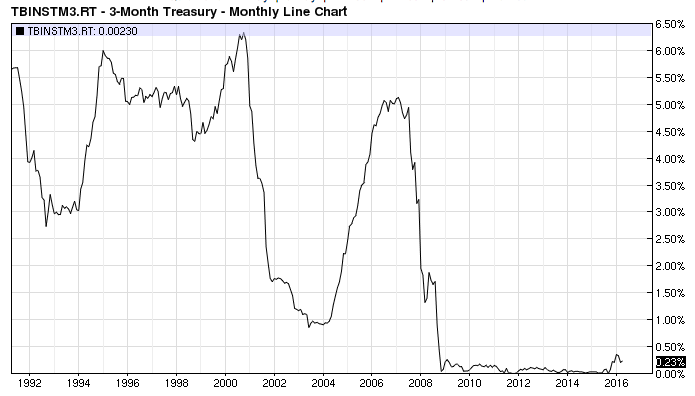
This chart showing 3 month T-Bill rates between 1992 and recent years illustrates (by contrast) just how low the Fed kept rates during World War II.
This Fed strategy proved helpful in achieving victory! However, at the end of the war, federal price controls were lifted … thereby igniting U.S. inflation:
13% inflation in 1947, and then 13% again in 1948.
This prompted the Fed Governors to become extremely concerned about artificially low interest rates. So the Fed began to lift its cap on short-term rates (which still rose to only about 1.12% by 1950!).
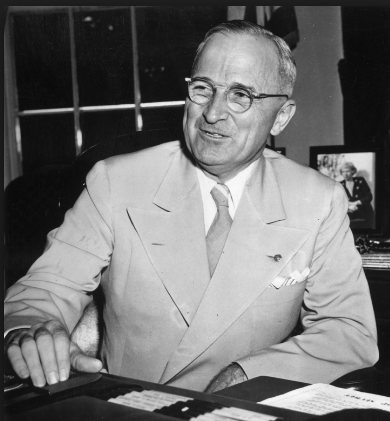
President Truman was determined to keep interest rates at rock bottom levels to facilitate the financing of World War II and the Korean War.
However, that seemingly reasonable decision cost then Fed Chair, Mariner Eccles, his job (although he remained a Governor through the remaining three years of his term). President Truman was quite displeased with Eccles’ decision, prompting Truman to replace Eccles with a supposedly more amenable Thomas McCabe. Significantly, I need to add (and emphasize) that the Treasury Department insisted that the 2.5% cap on government bond yields be maintained.[2]
If one focuses upon the “big picture” of events following World War II in the light of what we have already learned about central bank history… what happened next should have been quite predictable! All too soon following the Fed’s increase in short-term rates (and Eccles’ replacement as Fed Chair), the specter of war (the bane of managed government financing) rose once again! In Asia, simmering controversies within the Korean Peninsula boiled over into the Korean War. President Truman held an extremely dim view of “bond market vigilantes”[3] and therefore he was determined to prevent such persons from getting in the way of the “fight against communism”, which he saw (in those years) as focused in Korea.
That was the point at which economic reality and political priorities crossed paths so strongly that an amazing Washington “tug of war” ensued… pitting the President (and his Treasury Secretary) against the entire Federal Reserve! Truman wanted the Fed to lower interest rates in order to facilitate the significantly increased federal expenditures necessitated by the war in Korea.
However, a key economic reality in 1950 was that inflation was headed upwards toward 20%. Among many other things, new Fed Chair McCabe (and his predecessor, Eccles) were quick to recognize the inevitable results if the Fed lowered interest rates and maintained an artificial 2.5% cap on bond yields during a period already struggling with 20% inflation:
Investors would dump U.S. bonds, and as the “buyer of last resort”, the central bank would have to buy them all!!
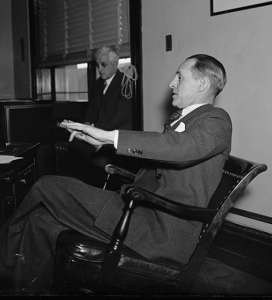
A central figure within the history of the Federal Reserve is Marriner Eccles, who lost his job as Fed Chair because he stood firm on a sound principle of monetary policy.
That result was totally unacceptable to financial minds as keen as those of McCabe and Eccles.[4]
Therefore, former Chair (and still Fed Governor), Eccles articulated the concerns of the Fed in testimony before Congress:
“As long as the Federal Reserve is required to buy government securities at the will of the market for the purpose of defending a fixed pattern of interest rates established by the Treasury, it must stand ready to create new bank reserves in unlimited amounts. This policy makes the entire banking system, through the action of the Federal Reserve System, an engine of inflation.”
For his part, the President Truman built his case (vis-à-vis the Fed) upon these twin principles:
1) U.S. patriotism and
2) The imperative of fighting the evil of Communism.
To that end, the president described the situation facing the country using phrases such as the following:
“The present emergency is the greatest this country has ever faced, including the two World Wars and all the preceding wars.”
Reflecting his passion, Truman even wrote to McCabe and Eccles that, if the Fed lifted the cap on bond yields, the Fed would be doing:
“…exactly what Mr. Stalin wants!”[5]
This “tug of war” between President Truman (and his team) and the Federal Reserve soon became a full-scale political battle. By the end of 1950, as the high costs of war became vividly real once again, the president found U.S. monetary policy to be entirely unacceptable.
Therefore, during the first two months of 1951, the U.S. Treasury Department embarked upon a bold attempt to “jawbone” the Federal Reserve into a more accommodative monetary stance (ie. reducing interest rates to as low a level as possible).
To execute this “jawboning” effort… U.S. Treasury officials used very public press conferences.
Alas, that PR effort was so inelegantly managed that even the most naïve of contemporary PR consultants will find the actual historical facts to be nearly unbelievable:
In January of 1951, the U.S. Treasury Secretary (John Synder) announced that consultations between President Truman and the Chairman of the Federal Reserve Board had led to a decision that new long-term debt issues would continue to be offered at a 2 1/2 percent interest rate.
However, despite those representations by federal Treasury officials, the actual fact was this: the Federal Reserve Chair was not aware of any such agreement (and found the 2.5% rate unacceptable)! Therefore it was natural that the Fed let it “slip” that it did not agree with the Treasury Secretary’s announcement!!
When this serious discrepancy regarding the “facts” became public… were any apologies offered or some form of “walk back” attempted by the folks at the Treasury Department?
Absolutely not! Instead, President Truman called (not “invited”) the entire FOMC to a White House meeting to discuss policy.
What happened after that White House meeting calls to mind a timeless insight from Albert Einstein (keep in mind, friends, what led to that “called” White House meeting between the Fed and Truman’s Treasury Secretary team in the first place):
Here is what occurred after that White House meeting:
The White House and the Treasury announced that the Fed would continue to support government bond prices.
However, the former Fed Chair (Eccles — who was still a member of the Board of Governors!) released the Fed's own confidential minutes of that White House meeting. And guess what — those minutes contradicted all White House and Treasury claims that the Fed had committed to keep rates fixed at a low level!!
As a result of these public disputes, the Federal Reserve asked the President to mandate negotiations between the Fed and the Treasury. Finally, in March of 1951, an “Accord” was announced:
“The Treasury and the Federal Reserve System have reached full accord with respect to debt-management and monetary policies to be pursued in furthering their common purpose to assure the successful financing of the Government's requirements and, at the same time, to minimize monetization of the public debt” (Federal Reserve Bulletin, March 1951, p. 267).
Now allow me to interject an interpretative note at this point (my personal interpretation… not that of any expert):
Any anal retentive (or even forensic) reader of that “Accord” will utterly fail to find any language that specifically clarifies that the Fed would support low bond interest rates… nor will she/he find any language that clarifies any “independence” of the Fed to conduct monetary policy. The fact is that many observers at that time felt that this Accord was neither a sufficient resolution nor a final resolution of this Treasury/Fed dispute.
However, the real (and long-lived) key to the future of the Fed lay in the much more subtle background of how the “Accord” was reached:
William McChesney Martin had been in service as Assistant U.S. Treasury Secretary for Monetary Affairs prior to 1951. At the time of the Fed/Treasury negotiation, the Treasury Secretary (J. Snyder) was in the hospital. Therefore Martin was pressed into service as the chief negotiator for Treasury.
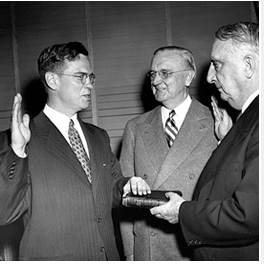
A key moment in Federal Reserve History was the swearing into office as Fed Chairman (by a Supreme Court Justice) of William McChesney Martin. In the middle is pictured Thomas McCabe, whom Martin replaced after a term of less than three years!
Part of the agreement related to the Accord was that the then Fed Chair (T. McCabe) would resign (six days after the Accord was announced) … giving Truman the political freedom to pick a new Chair.
Truman picked William McChesney Martin… with an overriding conviction that Martin would run the Fed “Truman’s” way.
However (and a huge however it is, my friends), as sometimes happens in history, folks chosen for a position sometimes “surprise” in totally unexpected ways! William McChesney Martin belongs to that group!
The record shows that (contrary to Truman’s strong expectation) Martin guarded Fed independence quite strongly and consistently – through the remainder of Truman’s time in office and throughout four succeeding administrations!! That is how/why Martin became the longest tenured Fed Chair (1951-1970). He served as Fed Chair for 18 years and 9 months.
It is also a fact that Martin’s years as Fed Chair included the nation's longest economic expansion, from 1961 to 1969. That growth period ended when the central bank was forced to begin raising interest rates in order to fight the rising inflation that was caused by Government spending during the Vietnam War.
Finally, Martin could be boldly outspoken. At the bottom of one economic slump, Mr. Martin warned the U.S. Congress that you can't ”spend yourself prosperous.”
Therefore, when you combine these facts—
1) Eccles, McCabe, and their colleagues steadfastly stood up to pressure from President Truman and the U.S. Treasury repeatedly during the late 1940’s and early 1950’s;
2) They called for negotiations with the Treasury to reach an “Accord”;
3) Despite the absence of specific language in the “Accord” granting the Fed independence regarding monetary matters… history shows that the existential result of these “dust ups” and the “Accord” has been greater freedom for the Fed in its conduct of monetary policy.
4) And I dare add that the greatest impetus within all of the above points toward cementing the independence of the Federal Reserve Board was the leadership of William McChesney Martin.
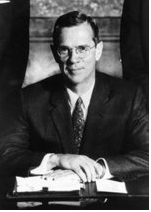
William McChesney Martin is a pivotal figure in the history of the Federal Reserve. He held that office for longer than anyone else, before or since.
In fact, when Martin died in 1998, (then) Federal Reserve Chair, Alan Greenspan) said:
“Crucially, Chairman Martin moved the Federal Reserve from being an adjunct of the Treasury Department… ‘to the independent status we know today.”[6]
Fed independence is not the only important achievement made by Martin. Here is a brief list of other ways he paved the path for basic “standard principles” for the Fed moving forward:
1) Although the primary mandate for the Fed was management of interest rates, Martin recognized that what seemed to be an elementary task is actually more complex than the average person would think.
a) Within the context of a dynamic national economy, he knew that Fed policy could not be pursued through the targeting of a single indicator.
b) Instead, he guided Fed members toward basing their decisions on a wide variety of economic variables and data points.
c) During FOMC meetings, he instituted the discipline of engaging all members with regard to their interpretation or understanding of what the economic environment suggested (on both a near term and an intermediate term basis).
d) He also made a point of building consensus. In fact, by disciplined solicitation of input from both governors and the presidents within the Fed system, he often secured unanimous votes on decisions made by the Fed.
2) One particular story illustrates Martin’s political acumen, as well as the sheer force of his will.
a) President Lyndon Johnson developed a widely attested ability to exert tremendous political pressure upon other people in order to coerce their support for his position.
b) Few senators or representatives were able to resist his relentless psychological and political pressure.
c) It is in that light that these stories about Martin prove quite remarkable:
Early in the Johnson Administration, the President informed Martin that he wanted low interest rates all of the time. The chairman replied that Johnson would have to get another man in the position of Fed Chair if that was some form of Presidential mandate.
Later, in December of 1965, Mr. Martin voted to raise the discount rate (the rate at which commercial banks borrow from the Fed) despite President Johnson's strong objections. After the vote, Johnson summoned Martin to Johnson's Texas ranch. Following that meeting, Martin faced a very curious and expectant press (expecting Martin to announce that he had changed his mind on rates). Instead, Martin reported that the meeting had changed neither man’s mind.
By the way, we occasionally hear commentators on Bloomberg, Fox, or CNBC refer to the Fed’s ability to “take away the punch bowl just as the party gets going.” You quite likely do not know that it was William McChesney Martin who coined that attention-getting thought!
THE CURRENT FEDERAL RESERVE:
We all know that former Chair, Ben Bernanke, initiated an unprecedented era of “Quantitative Easing” (QE) in 2010… a policy that grew and morphed into other iterations of monetary easing (including “Operation Twist”) until any additional bond buying (the vehicle used for the easing) was stopped in October of 2014. By that point, the Federal Reserve had injected over $3.5 trillion into the U.S. economy – quadrupling the size of its 2007 Balance Sheet. For comparative purposes, consider this fact
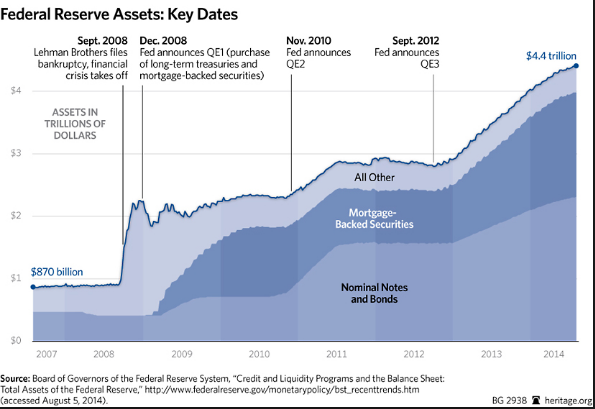
Here is a graph of how the Balance Sheet (B/S) of the Fed ballooned with the growth of Quantitative Easing!
That $3.5 trillion is approximately (in 2014 terms) the size of the entire German economy in that year!
That was not the end of it however. Figuratively speaking, if “QE” was a disease, it was obviously a contagious one – because essentially all major global central banks have adopted a parallel strategy since Bernanke introduced “QE” in the U.S.[7]
Needless to say, as the world has been increasing flooded with “money” from central banks, equity asset prices have moved upward! After all, all that money needs a “home”.
More disturbing, the markets have become so attached to (dependent upon) news surrounding central bank meetings that it has a tendency to move upward during periods just before and just after a meeting of the Federal Open Market Committee to a greater degree than it does during “non Fed Board Meeting” periods!!
Sadly, as a consequence, watching the business/market channels has become as much a matter of nearly constant “Federal Reserve” chatter as it has been a parade of revealing vignettes/reports on actual “fundamentals” – such as corporate earnings, economic data, and economist predictions of what lies ahead.
In my estimation there are two overarching (and yet related) issues regarding how the Federal Reserve currently carries out its work that have proven counter-productive in its effective management of its responsibilities:
1) UNFOCUSED COMMUNICATION
How should the Federal Reserve communicate regarding its policy-making and its regular operations? And perhaps just as important, how much and how often should Fed leaders communicate?
Those are questions that are in no way new. However, in recent years they have received exponentially more attention because (as we have seen above) the unprecedented level of global monetary easing has become the predominant mover of the financial markets.
So what can be said about Fed communication?
First, consider this quote:
“The more fully the public understands what the function of the Federal reserve system is and on what grounds and on what indications its policies and actions are based, the simpler and easier will be the problems of credit administration in the United States.”
Can you guess who wrote that, and how recently?
If I didn’t know the answer, I would have guessed it was either one of the two most recent Fed Chairs (Bernanke or Yellen) because they have both been quite outspoken in their advocacy for greater Fed “transparency”.
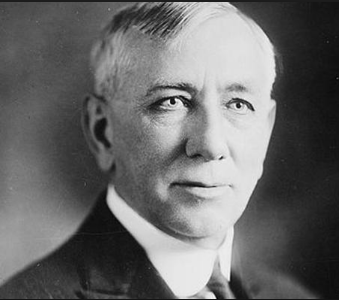
If you want to confound your friends, show them this photo and ask: “Who is this man?” He is Daniel Crissinger, Fed Chair from 1923 to 1927.
However, I would have been mistaken. In fact, that statement is 93 years old – since it is actually a snippet from the 1923 Annual Report of the Federal Reserve Board (page 38).
It is interesting that the Board published that statement in 1923, because in point of fact, the actual conduct of the regular operations of the Fed has historically (at least until relatively recently) been largely “out of public view”.
This was long the view of most central bankers from the earliest days of central bank history (ie. the Bank of England (BOE) was founded in 1694). In this regard, the opinion of Montagu Norman (Governor of the BOE between 1921 and 1944) was typical.
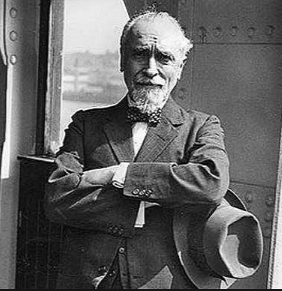
This is Montagu Norman, a former Governor of the Bank of England. He was also 1st Baron Norman DSO PC.
It has been written that his personal motto was: “Never explain, never excuse.” In other words, he (and his central bank colleagues) felt that monetary policy was an arcane and esoteric art… and more to the point, was an art that was best practiced out of public view.
Lest you think that Mr. Norman was merely an old style British stuff shirt, consider that none other than our own Janet Yellen shared this insight in a 2012 speech at the Haas School of Business, University of California at Berkeley:
“When I started my first job [in finance]… it was an article of faith in central banking that secrecy about monetary policy decisions was the best policy: Central banks, as a rule, did not discuss these decisions, let alone their future policy intentions.”
Therefore, it is clear that until recently, the leaders at the Federal Reserve made it a practice (if not an unwritten policy) to keep themselves and their work largely out of the public eye. In fact, I dare say that if an interviewer had walked the aisles and back hallways of the New York Stock Exchange, the Chicago Board of Trade, or the Chicago Board of Options Exchange between 1973 and 2005, most of those present would likely have been able to correctly identify the Chair of the Fed, but would have stumbled at identifying the names of even one-fifth of the other members of the Fed Board of Governors. More pointedly, I believe that if average citizens on the streets of New York City, Philadelphia, Chicago, San Francisco, etc. had been surveyed with regard to any of those Fed-related names, much less than one-third would have been able to identify the Fed Chair, much less any of the Governors or regional Bank Presidents.
To be even more specific, other than the big “dust up” between the Fed Governors and President Truman’s administration in 1950-51, the public rarely heard of (or read about) Fed policy-making and operations … except when the Federal Reserve Chair appeared for the prescribed bi-annual reports to Congress and/or the press (and commentators) opined about the success or failure of a particular Chair whenever it came time for the U.S. President to either re-appoint that chair or choose another. [For a more detailed account of several periods of Fed Chair transition during an especially enlightening era (1970-1990) and what those transitions can teach us about the complexity of effective monetary policy, see our next article, being published very soon.]
In sharp contrast to the above “tradition” in central banking, ever since the Financial Crisis of 2007-09 and Bernanke’s introduction of “Quantitative Easing”, the Markets and the public at large have become increasingly barraged by public pronouncements from practically every person with a title at the Federal Reserve. Consider this observation from none other than Ben Bernanke himself [from his November 6, 2015 Brookings Blog post]:
“As many as nineteen Fed officials—the seven Board members (when all seats are filled) and twelve Reserve Bank presidents—comment regularly on the economy and monetary policy, and their messages can vary widely.
“The diversity of voices has engendered frequent complaints about cacophony from market participants and the markets-oriented media. Many ask, can’t Chair Yellen do a better job of herding her cats?”
“The complaint is understandable, but it reflects an incomplete understanding of both the communications process at the Fed and of the purposes of the Fed’s public commentary. Regarding process: Board members and Reserve Bank presidents are not the chair’s subordinates. Rather, they are, to a substantial extent, independent policymakers. (Board members are individually appointed by the president and confirmed by the Senate. The Board as a whole must approve the selection of Reserve Bank presidents, but those decisions are not based on policy positions.) The chair consequently has little or no ability to orchestrate what FOMC participants say, even if she were inclined to do so. When I was chair, I sometimes got advance copies of participants’ speeches as a courtesy; but my approval was not necessary or expected. What you hear from the Fed is policymakers’ unfiltered, unorchestrated opinions!
“Is there a case, then, to change the institutional structure of the Fed to limit public pronouncements on monetary policy? I don’t think so. The diversity of opinion coming from the Fed serves some important purposes, over and above communication to markets:
1) FOMC participants typically get only a few minutes to express their policy views in the meetings themselves. Public speeches are a forum for elaborating and providing evidence for their positions. Think of policymakers’ speeches as a continuation of the FOMC debate in other venues.
2) Importantly, the open airing of policymakers’ opinions and analysis actively engages the public in debates about critical issues. For example, a key question for the FOMC is whether significant slack remains in the labor market. Airing this issue has invited people outside the Fed to think and write about the question, and in fact there has been a lively debate about it in academia, the media, and the blogosphere. Fed policymakers are certainly aware of and not infrequently influenced by outside analysts.
3) For democratic legitimacy and accountability, the Fed needs to be transparent about how it makes monetary policy decisions. Commentary by FOMC participants allows the public to see the policy discussion in action and to better understand the relevant issues. It should also be reassuring to those who disagree with Fed decisions to know that, more often than not, their point of view is being represented in the Fed’s internal debates.
“What then about the market participant who just wants to know the policy bottom line? Who should he or she listen to? There are two conduits for the FOMC’s collective decisions: its post-meeting statement and the chair’s commentary on behalf of the Committee (notably, in the post-meeting press conferences and in Congressional testimony). For those with limited time for Fed-watching, those official channels provide the best information about what the Committee is thinking and how it is likely to act.”
The problem with so many Fed-related “voices” speaking publicly is that market participants (big and small) currently crave information from the Fed… hoping to glean “hints” regarding future interest rate moves. Therefore, with multiple “voices” offering varying opinions (that often conflict with one another), the market is pushed up one day and then pushed down the next by these recurring instances of “Dueling Fedspeak”.
And as though that wasn’t bad enough… these vocal Fed leaders often end up “disagreeing” even with him or herself! [They prefer to say they changed their mind!] Let me offer a classic example from the period that led up to the September 2015 Fed meeting:
During the summer, New York Fed President (William Dudley) had argued that the economy was strong enough for rate hikes in 2015 … but then in October he was quoted by an Italian newspaper that growing concerns about poor global growth clearly made it too soon to consider a rate hike: “The situation changed over the last few months.”
When we turn to Atlanta Fed President (Dennis Lockhart) we find him having opined in August that it seemed it would be hard for the Fed to resist raising rates. For better or worse, some key market observers consider Lockhart something of a “bellwether” regarding Fed policy… so the market reacted more than usual.
Then a strange thing happened…
Despite the fact that economic data didn’t materially change between then and the September Fed meeting … the Fed somehow “resisted” a rate hike (contrary to Lockhart’s conjecture). The most singular change between mid August and the September meeting was the new “Black Monday” (8 24 15) – when U.S. stocks opened down by 1,086 points and ended up down by “just” 588 points. However, the chief factor cited within the written Fed decision to not raise rates was “uncertainty about the slowdown the China’s economy”.
Next we have Fed Vice Chair (Stanley Fisher) who made a couple of appearances for the media during that period prior to the September meeting. Demonstrating a true penchant for political double-talk…
Fisher first highlighted weak inflation (a point in favor of not hiking rates) and then moved on to focus on economic metrics that point toward a strengthening economy (a point in favor of higher rates). Then just three weeks before the Fed meeting, Fisher said the following on CNBC – “it’s too early to tell” if the Fed should raise rates.
So, reeling with confusion and uncertainty, the “Markets” awaited the September 17th Fed decision with even more than the usual rapt attention. When the decision was announced to not raise rates… everyone could assume that the issue was settled, correct?
Please… you have got to be kidding! At times it appears that the most consistent trait of this Fed is that it enjoys confusing as many folks as possible.
Why do I say that[8]? This is why:
On the 19th of September, the San Francisco Fed President (John Williams) publicly opined as follows:
“Given the progress we’ve made and continue to make on our goals, I view the next appropriate step as gradually raising interest rates, most likely starting sometime later this year.”
Hmmm!! No wonder I think confusion seems to be the Fed’s objective! However, it gives me some comfort to know that I am not the only one who feels this way. Consider this tweet made by the President of the Peterson Institute for International Economics (Adam Posen):
“This is no way to run a railroad. All FOMC voters should speak but should coordinate, not fight for oxygen.”
Amen!
Now, to be “fair and balanced”, I feel obligated to briefly share why Ben Bernanke disagrees with me:
1) First, in his 2015 book [The Courage to Act], Bernanke contends that Fed policymakers’ speeches “aren’t just about policy; they are policy tools.”
2) In his November 6, 2015 “Ben Bernanke Blog” post at Brookings.edu, Bernanke lists reasons why the current diverse communication policy should not be changed;
a) “FOMC participants typically get only a few minutes to express their policy views in the meetings themselves. Public speeches are a forum for elaborating and providing evidence for their positions. Think of policymakers’ speeches as a continuation of the FOMC debate in other venues.”
b) “[this process] actively engages the public in debates about critical issues;
i) “For example, a key question for the FOMC is whether significant slack remains in the labor market. Airing this issue has invited people outside the Fed to think and write about the question;
ii) “… in fact there has been a lively debate about it in academia, the media, and the blogosphere. Fed policymakers are certainly aware of and not infrequently influenced by outside analysts.”
c) “For democratic legitimacy and accountability, the Fed needs to be transparent about how it makes monetary policy decisions. Commentary by FOMC participants allows the public to see the policy discussion in action and to better understand the relevant issues.”
All of that being said, the above reflects Bernanke’s personal opinion… and one with which I could agree if we were merely talking theory… without reference to the unreasonable and volatile degree to which such individual speeches move the financial markets on any given day – until that is, an opposing view is aired in a speech the next day and the market moves with equal emotional volatility in the opposite direction! Such back and forth volatility achieves no positive economic benefit… merely serving to enhance the ability of traders to profit from the volatile swings in price.
So why is Bernanke so firmly entrenched in his view? I suspect he is committed to breaking the mold of public perception that the successful operation of the Fed depends upon the omniscient leadership of a larger than life “genius”[9] of persons such as William McChesney Martin, Paul Volcker, or Alan Greenspan – all of whom were practically worshipped by Wall Street.
I will confess that his vision of a more collegial and collective Fed is quite laudable in the abstract. However, a huge number of observers agree with me that, in practice, the current Federal Reserve communication style (emphasizing its diversity) has merely served to create a cacophony of “voices” that have created so much market “noise” that it is perpetually distracting, confounding, and counter-productive vis-à-vis the operation of an orderly, rational market.
Another reality that is hardly ever apparent to the average viewer of televised financial news is that it is often the less powerful Fed regional bank presidents who are the most frequent “speaking circuit” voices… rather than the more influential board governors. That (obviously) has the effect of public misunderstanding regarding the existential “weight” of opinion within the Fed that is most likely to guide future decisions.
One final observation is this:
Were you aware that the Fed has a policy that intentionally avoids the linking a specific calendar date with any given policy decision?
Of course you didn’t know that! And the reason is that Fed officials keep suggesting such specific links (or at least strongly hinting at them) in their various speeches!
Talk about precipitating misunderstanding and confusion!
2) EFFECTIVE ECONOMIC PROJECTIONS
With regard to the Federal Reserve’s record regarding projections of future U.S. economic data and trends, a very old quote from the famous American humorist, cowboy, actor, columnist, and social commentator, Will Rogers[10], comes to mind:
“An economist's guess is liable to be as good as anybody else’s.”
If you think about that quote… it does put such projections into proper focus! Namely, the task of offering a national economic projection within a world that is more global than ever before is so complex and perplexing that I am about as likely to “get it right” as is Janet Yellen (a “dove”) or Esther George[11] (a “hawk”).
As we saw earlier, those who are leaders within the Fed have become notorious for being “off the mark” in their projection of future economic conditions. Perhaps the most telling of these “off the mark” projections came in December, when the Fed announced its historic interest rate hike (the first such hike since 2006). The detail included in the minutes of its deliberations indicated that the Fed expected that conditions during the following 12 months might support as many as four additional hikes.
What was the reaction of the Market? Simply put, it was strong “Disbelief”!
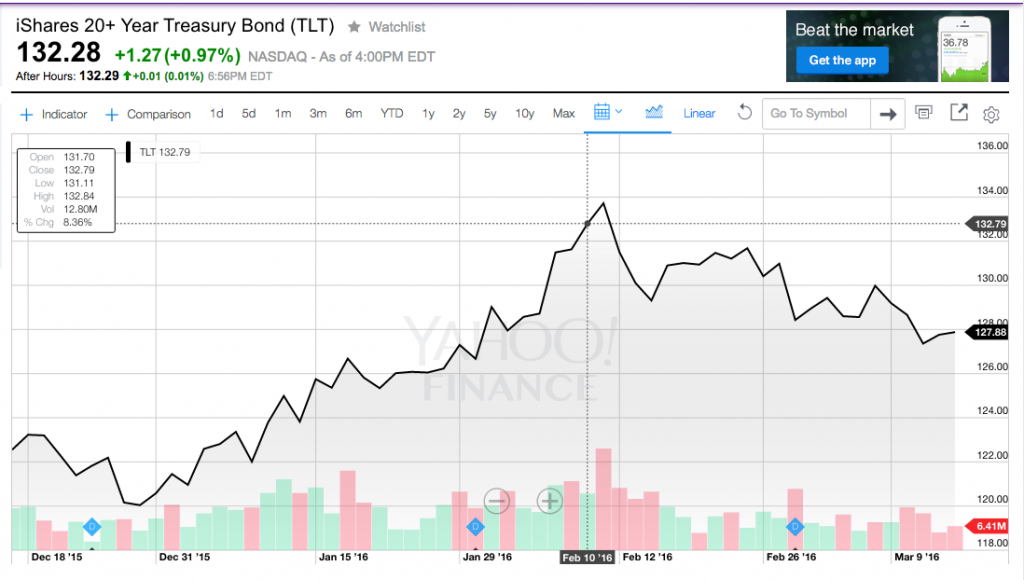
A graph of the market's reaction to the 12/16/15 decision by the Fed to raise rates… and suggesting there could be four more rate hikes in 2016.
Looking at the above chart (from 12/16/15 to 3/15/16) of the iShares 20+ Year Treasury Bond (TLT), bond prices went up on the very day the decision was announced, then trended downward through the remainder of December. However, in January it moved steadily upward until February 11th – catching countless traders off-guard and indicating that the Market did not agree with the projection offered by the Fed in December. In fact, bond interest rate futures indicated that only 9% of market participants agreed with that Fed assessment (per Bloomberg)!! Adding detail, those futures movements implied that only one or two rate hikes were likely during 2016… with quite a few outspoken observers suggesting that not even one hike was “set in the stars”!
This is just one example of the Market not demonstrating full faith in the Fed (or even partial faith)!
On this topic, one of the reasons for less than “full faith in the Fed” is the continuing confusion that is generated by Fed projections through its use of “Dots”!
To make a long story short, “Dots” is a tool published quarterly by the Fed that has nothing to do with the classic old boxed candy… and is not nearly as satisfying as that candy!
The so-called “Dot Plot” is a visual accompaniment to the FOMC’s “Summary of Economic Projections – a table of economic metrics that is released in conjunction with a Fed policy decision statement.
The “Dot Plot” consists of the following:
The seventeen designated leaders within the Federal Reserve System anonymously provide her/his predictions for the target fed funds rate at the end of the year of the report… and then each of the following few years, and finally, for the longer term.
Those metrics are imaged in a chart that includes a dot for each one the members at their target interest rate level for each time period.
There are numerous reasons why the “Dots” fail short of adding to the so-called “Transparency” hoped for by Bernanke, Yellen, et al:
1) Because the “Dots” are totally anonymous, they too often become merely a “Guessing Game”[12] … as Fed watchers and pundits go about trying to guess which “Dot” belongs to Yellen, which to Dudley, which to Bullard, etc.
a) The result is too much energy spent in a fruitless, totally subjective, and unproductive pursuit.
b) It surely does not provide a clear picture of the Fed's “majority view”.
2) Each of the designated “seventeen” participants give a unique weight to each single piece of economic data… and each one holds rather unique perspectives on total monetary policy… so even dots that overlay one another are likely to mean different things to those who put them there.
3) The director of the Center for Financial Economics at Johns Hopkins University (Jon Faust) has opined that the rate forecasts:
“seldom add anything useful beyond the communication already presented by the Fed — press conferences, the statement, speeches, and testimony… We should have all learned that they don’t say where policy is going.”
It is notable that Faust formerly served Yellen as an adviser on communications!
4) On a regular basis, Fed members end up ratcheting their “Dots” downward… when it turns out that their earlier predictions proved to be too optimistic.
When that happens, market observers jump all over the Fed… as though those Fed leaders should have been omniscient. Needless to say, it detracts from overall Fed “credibility.”
5) Even some Fed leaders are not happy with the “Dots”.
a) In a recent Bloomberg News interview, the President of the St. Louis Federal Reserve Bank (James Bullard) expressed his concern that such rate projections contribute to uncertainty.
b) He then continued: “I’ve even thought about dropping out unilaterally from the whole exercise.”
INVESTOR TAKEAWAY:
So what does this account suggest to us as traders, investors, or merely a U.S. citizen?
1) A Central bank can prove to be effective as a restraining influence on national politicians who tend to believe the easiest way out of a problem is to “borrow and spend”… preferably at a low interest rate;
2) A Corollary: Unfortunately, central bankers can be co-opted or manipulated by political leaders to keep interest rates low so the cost to service escalating national debt loads is reduced.
3) To oversimplify, we have reviewed two basic “models” of Federal Reserve leadership:
a) Strong Leader Model:
This model was best epitomized by the leadership of William McChesney Martin (who continued in the tradition of M. Eccles and T. McCabe … “standing up” to presidential political pressure).
In our follow-up article, it will become obvious that Paul Volcker and Alan Greenspan epitomize this “Strong Leader” model as well.
b) Collegial Style Model:
As you read earlier, this is the model toward which Bernanke was striving.
However, I think many of you will agree that this model, however noble in principle, is particularly dysfunctional in the current market environment that has become so hyper “Fed Dependent”.
Based on the market’s current propensity to eagerly anticipate every single Federal Reserve meeting in much the same way that a child anticipates receiving candy at Halloween (or a cocaine addict craves a “fix”). However, all that an eager “public” receives is a cacophony of “Fed Voices”, combined with the widespread confusion that is precipitated by each new release of the “Dot Plot”.
Ultimately, however, the “Bernanke Fed” will not go down in history as being a Fed that lacked a “dominant leader”. The truth is that Bernanke, the “Father of Quantitative Easing” was such a dominant force within the U.S. that other global central bankers have seen fit to follow in his path.
4) Ultimately, what I believe we should take from these first two articles is the following:
a) No Federal Reserve Governor of Regional President is omniscient; their projections are entirely fallible.
b) No matter what the “Market” thinks “should” happen, the Fed has demonstrated some unpredictability, as well as a willingness to “walk back” on projections they offered in prior quarters.
c) So although we should never “Fight the Fed”… neither should we try to “outguess the Fed”
5) I regret to say that, in my opinion, the chief result from Bernanke’s attempt to foster a “collegial” Fed is enough obfuscation, misunderstanding, misinterpretation, and confusion to foster (instead) a veritable “Cottage Industry” of folks who have declared themselves an “Expert” on Fed operations, policy deliberations, behind the scenes developments, and “the next decision”.
a) Just prior to each new meeting, these “experts” get paid to offer their authoritative opinion regarding the question “WWTFD”: “What Will the Fed Do?”
b) Each such “expert” will be pleased to collect their check as they present, with seeming total confidence, what that impending decision will be.
c) The problem is, of course, that such “experts” have predicted 15 out of the past1 rate hikes!!
6) A corollary to point 5) above is simple:
a) Don’t spend so much of your precious time listening to the usually pointless handwringing, prophesying, and pontifications of the countless self-proclaimed “Fed experts” who pop-up like weeds within the financial media!!
b) In fact, it might be helpful to keep the Federal Reserve in perspective through comedic genius of Will Rogers:
“There is two things that can disrupt business in this country. One is War, and the other is a meeting of the Federal Reserve Bank.” (4/2/1929)
“See where Congress passed a two billion dollar bill to relieve bankers' mistakes. You can always count on us helping those who have lost part of their fortune, but our whole history records nary a case where the loan was for the man who had absolutely nothing. Our theory is to help only those who can get along, even if they don't get a loan. The author (obviously) finds the Fed and its history far too fascinating!! But at least he can take comfort in the fact that he no longer believes anything any Fed official says at any given time, nor anything any given “Fed expert” spews forth on TV… and absolutely never tries to “outguess the Fed” in his investment decisions!” (1/22/1932)
DISCLOSURE:
The author (obviously) finds the Fed and its history far too fascinating!! But at least he can take comfort in the fact that he no longer believes anything any Fed official says at any given time, nor anything any given “Fed expert” spews forth on TV… and absolutely never tries to “outguess the Fed” in his investment decisions!
Finally, I should disclose (and clarify) that this article was written almost 2 weeks prior to the May 18th release of the April Fed Minutes. The author feels that these new “proclamations” do not hold any more (or less) credibility that all the prior such proclamations from Fed leaders!
Nothing in this article is intended as a recommendation to buy or sell anything. Always consult with your financial advisor regarding changes in your portfolio – either subtractions or additions.
FOOTNOTES:
[1] I will leave to others the development of a definitive list of reasons such panics occurred. But certainly it is fair to identify “unchecked greed” and “excessive risk” as among the historical causes of such panics, as we witnessed within the 2007-2009 Financial Crisis.
[2] Evidently, President Truman vividly remembered that his family had lost money on the World war I era “Liberty Bonds” following that war, and he was determined to spare his supporters from loss on the World War II era bonds!
[3] Truman feared the “vigilantes” would push rates up to levels quite troublesome for government borrowing and debt service.
[4] Actually, a number of economic commentators and historians have opined that the comprehensive understanding demonstrated by McCabe and Eccles regarding the link between expanding federal debt, inflation, and a potentially unlimited expansion of monetary policy (ie. money supply) was (essentially) “ahead of their time”.
[5] [Note: Joseph Stalin was then the head of the U.S.S.R.]
[6] It is worth noting that as his pre-Fed career advanced, Martin became the first paid president of the New York Stock Exchange and was referred to as ‘boy wonder of Wall Street.” But he demonstrated profound patriotism when, at the start of World War II he left his $48,000/year salary to earn $21/month in the U.S. armed forces!
[7] The major (and most notable) practitioners of “QE” are the ECB, the BOE, the BOJ, and the PBC.
[8] Am I just a hopeless cynic?
[9] Some might suggest the adjective “demi god” …
[10] In my opinion, many of the observations Mr. Rogers offered in his day qualify him as a Fed expert more than most of today’s self-proclaimed ones! Besides, he has an international airport named after him… something those others can not claim!!
[11] President of the Federal Reserve Bank of Kansas City
[12] I liken it to “Where’s Waldo”… as supposed experts try to identify Yellen’s “dot”, etc.
Related Posts
Also on Market Tamer…
Follow Us on Facebook

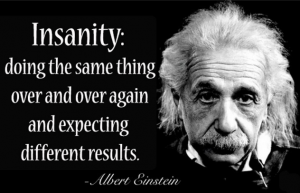

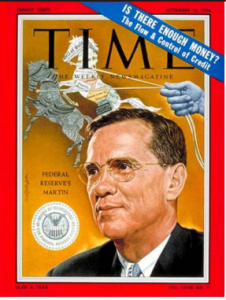
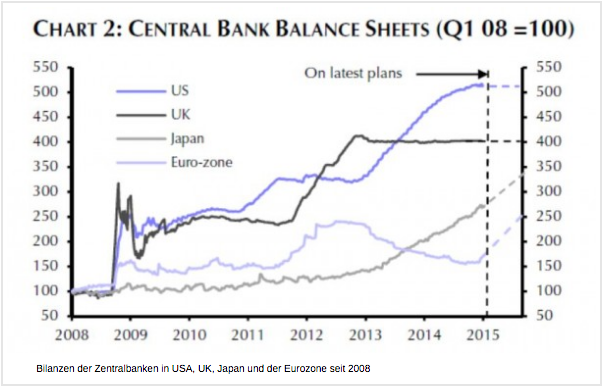
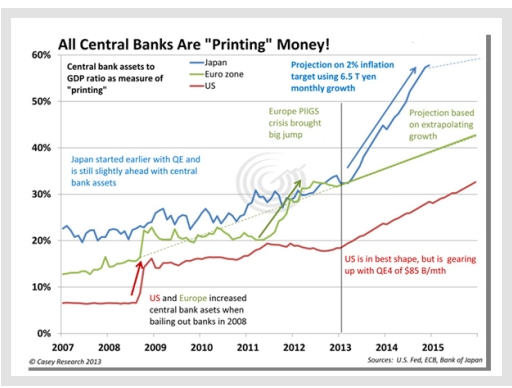
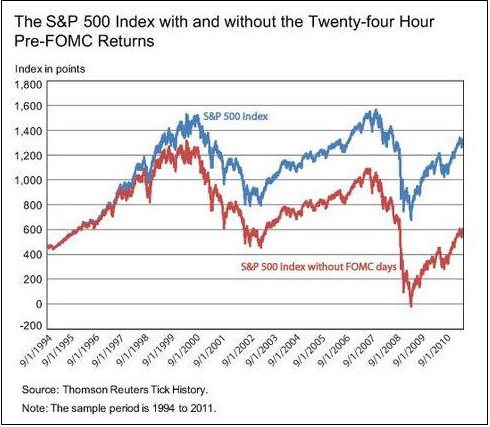
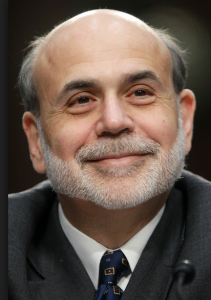
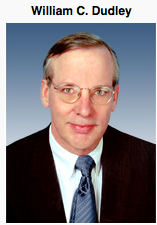
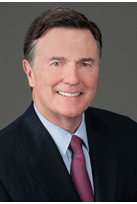
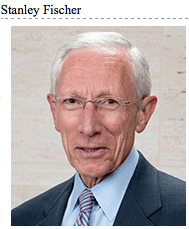
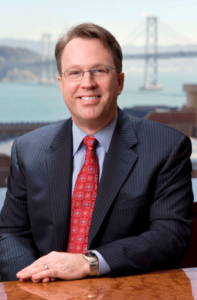
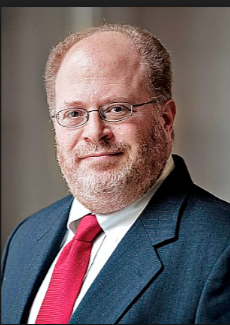
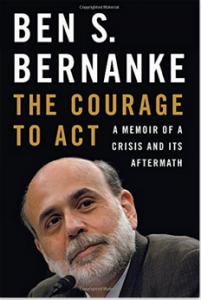
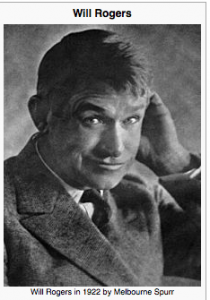

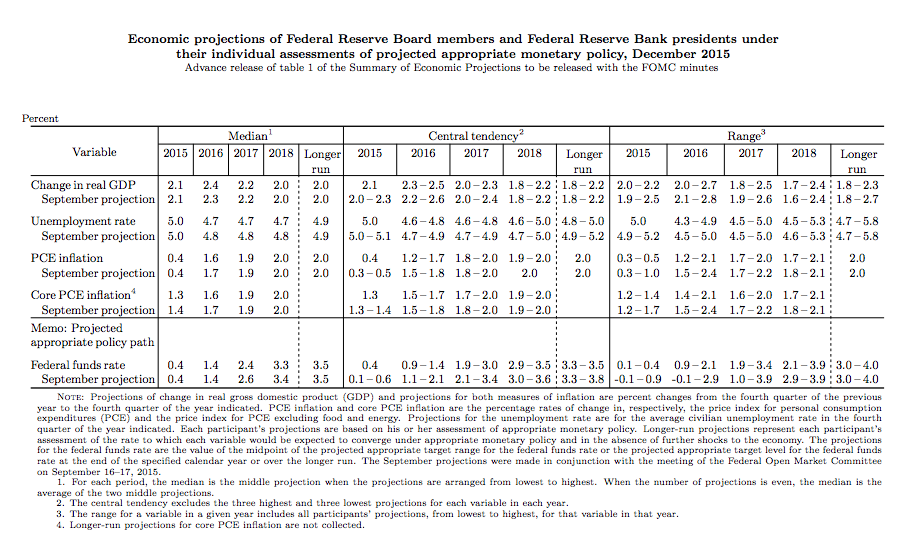
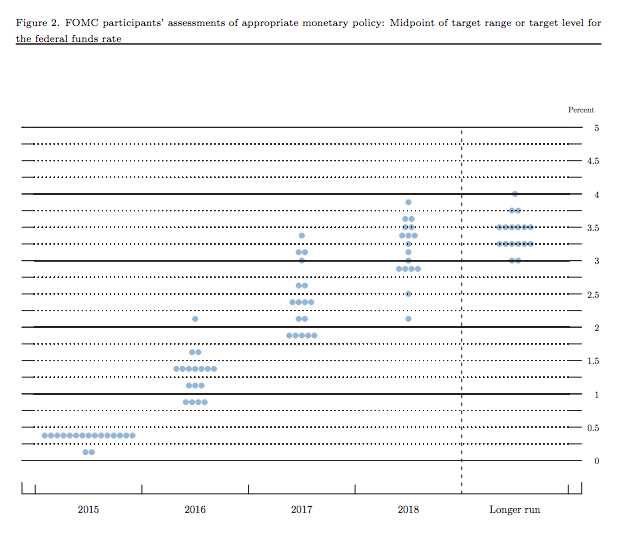
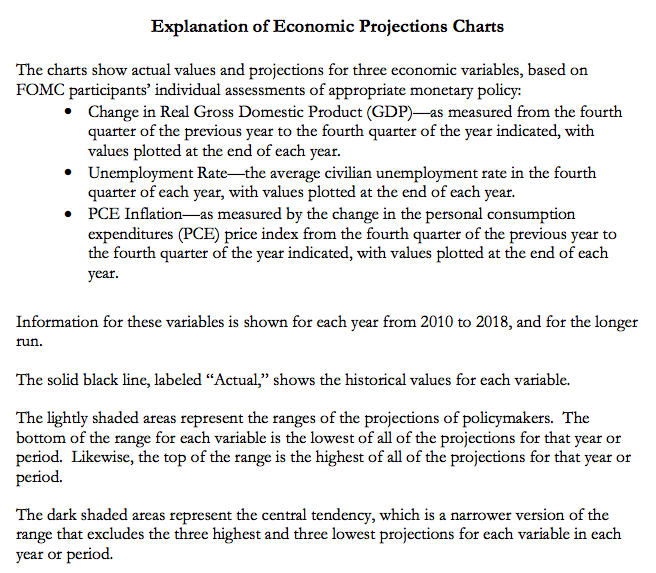
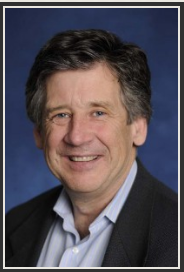
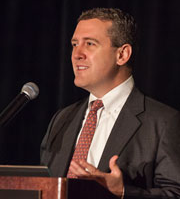
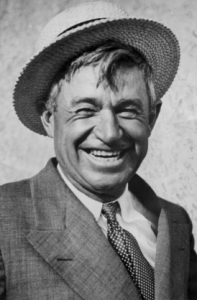
 Should Dividend Stock Investors Buy Coca-Cola Stock Instead of PepsiCo?
Should Dividend Stock Investors Buy Coca-Cola Stock Instead of PepsiCo?
